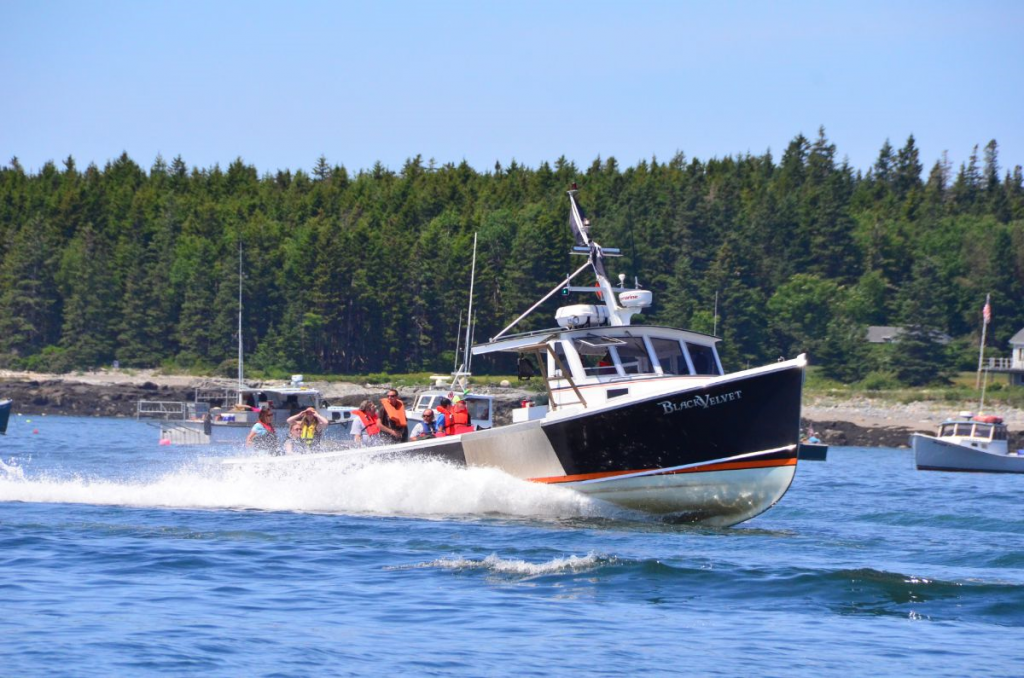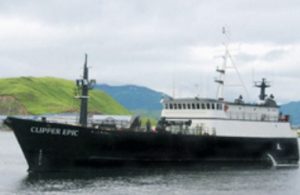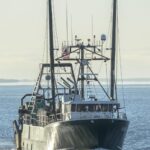Tag Archives: Chinook salmon

This Is Why You Don’t See People-Sized Salmon Anymore
While the orcas of Puget Sound are sliding toward extinction, orcas farther north have been expanding their numbers. Their burgeoning hunger for big fish may be causing the killer whales’ main prey, chinook salmon, to shrink up and down the West Coast. Chinook salmon are also known as kings: the biggest of all salmon. They used to grow so enormous that it’s hard now to believe the old photos in which fishermen stand next to chinooks almost as tall as they are, sometimes weighing 100 pounds or more. >click to read<11:06
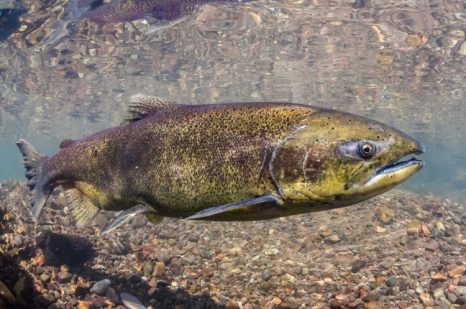
Largest Chinook salmon disappearing from West Coast
The largest and oldest Chinook salmon — fish also known as “kings” and prized for their exceptional size — have mostly disappeared along the West Coast. That’s the main finding of a new University of Washington-led study published Feb. 27 in the journal Fish and Fisheries. The researchers analyzed nearly 40 years of data from hatchery and wild Chinook populations from California to Alaska, looking broadly at patterns that emerged over the course of four decades and across thousands of miles of coastline. In general, Chinook salmon populations from Alaska showed the biggest reductions in age and size, with Washington salmon a close second. >click to read<17:14

Fish Board: Spotter planes out, Chinook actions on hold for now
The Alaska Board of Fisheries voted to ban spotter planes in Southeast salmon fisheries and provided some relief to struggling commercial troll fishermen on Friday, the first full day of deliberations for the board. Though the board made significant changes to Southeast finfish regulations, Juneau fishermen were left with a cliffhanger: salmon action plans aimed at protecting struggling Taku and Chilkat river Chinook — which could leave fishermen docked for a significant part of the season — won’t be voted on until at least Saturday morning. >click here to read< 17:19
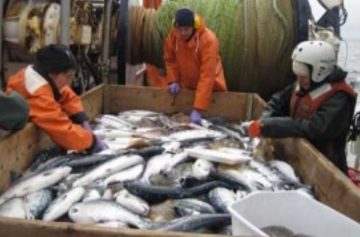
Money fish rule
Once more trawlers in the Bering Sea have gone to court in an effort to stop the National Marine Fisheries Service (NMFS) from billing them for the costs of managing Chinook salmon in the Bering Sea.,,, U.S. Commerce Department “cost recovery regulations, as applied to catcher-processor sector participants violate the (Magnuson-Stevens Act) MSA and (Administrative Procedures Act) APA, are arbitrary, capricious, an abuse of discretion and not in accordance with law, and are in excess of statutory jurisdiction, authority or limitations and short of statutory right,” the trawlers charged in a lawsuit filed Tuesday in the U.S. District Court for Alaska. click here to read the story 08:25

This area of Canada is becoming known for its truly gigantic salmon
Ted Walkus may have made the catch of the year at Rivers Inlet, B.C. Walkus, a hereditary chief of Wuikinuxv First Nation, caught a salmon that makes the fish most of us see at the supermarket look like sardines. It was a 50-pound monster, nearly as tall as Walkus himself. Catching a fish this big isn’t a total anomaly in the area. Rivers Inlet is known as something of a lost world, one of the only places on Earth where massive Chinook salmon are born. The biggest-ever salmon caught in the area was an incredible 83.3 pounds. click here to read the story 15:50

Net-mounted LED lights help reduce bycatch in Pacific hake fishery
LED lights can help reduce bycatch by aiding the escape of Chinook salmon from Pacific hake trawl nets, according to a study done by researchers at the Pacific States Marine Fisheries Commission and the Northwest Fisheries Science Center. The lights influence where salmon exit bycatch-reducing windows in the hake nets, and could increase the total number of salmon that escape, the researchers say. In a series of tests in 2015, the lights seemed to attract the Chinook salmon. During the tests, 86 percent of the salmon that escaped used the openings framed by LED lights. click here to read the story 15:48
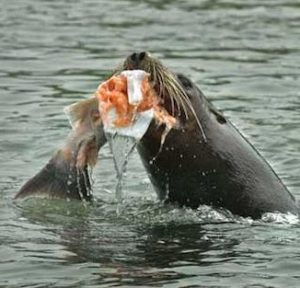
Endangered orcas compete with seals, sea lions for salmon
Harbor seals, sea lions and some fish-eating killer whales have been rebounding along the Northeast Pacific Ocean in recent decades. But that boom has come with a trade-off: They’re devouring more of the salmon prized by a unique but fragile population of endangered orcas. Competition with other marine mammals for the same food may be a bigger problem than fishing, at least in recent years, for southern resident killer whales that spend time in Washington state’s Puget Sound, a new study suggests. click here to read the story 07:43

Record Chinook Salmon, Steelhead Returns Reported on Mokelumne River
For many years after Camanche Dam was built, the Mokelumne River, a major tributary of the San Joaquin River and the Delta, hosted small runs of Chinook salmon. The historic runs of steelhead after the construction of the dam averaged only 100 fish and no steelhead returned to spawn many years. But both steelhead and salmon runs have rebounded in recent years, due to a number of factors. In welcome good news for Central Valley salmon populations, the California Department of Fish and Wildlife (CDFW) and the East Bay Municipal Utility District (EBMUD) report record fall spawning returns of Chinook salmon and steelhead to the Mokelumne River, a tributary of the San Joaquin River.,, The hatchery has received 13,799 adult salmon to date—compared to 4,129 at this point last year—and is expected to break the record return of 18,000 in 2011. click here to read the story 20:33
Warning signs for salmon
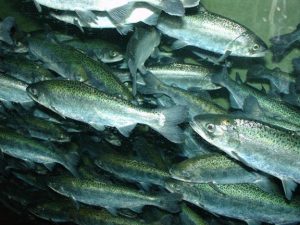 The numbers of young salmon caught off the Oregon and Washington state coasts during an annual federal survey cruise this June were among the lowest recorded in the past 20 years. In fact, numbers were low across nearly all the species researchers regularly catch or observe — from birds like the common murre to forage fish like anchovies and smelt. Months ahead of schedule, as a kind of heads up, West Coast researchers, project managers and program directors decided to send out a memo in mid-August detailing their initial findings — data that would usually be combined with other information and put out on a webpage at the end of the year. The data is preliminary, but researchers say it is clear many young coho and Chinook salmon didn’t survive the migration from freshwater streams and rivers to the ocean this year, while poor ocean conditions could impact salmon returns to the Columbia River for the next few years. click here to read the story 21:44
The numbers of young salmon caught off the Oregon and Washington state coasts during an annual federal survey cruise this June were among the lowest recorded in the past 20 years. In fact, numbers were low across nearly all the species researchers regularly catch or observe — from birds like the common murre to forage fish like anchovies and smelt. Months ahead of schedule, as a kind of heads up, West Coast researchers, project managers and program directors decided to send out a memo in mid-August detailing their initial findings — data that would usually be combined with other information and put out on a webpage at the end of the year. The data is preliminary, but researchers say it is clear many young coho and Chinook salmon didn’t survive the migration from freshwater streams and rivers to the ocean this year, while poor ocean conditions could impact salmon returns to the Columbia River for the next few years. click here to read the story 21:44
Kings off limits starting Thursday: ADF&G cites low chinook salmon stocks coastwide
 The Alaska Department of Fish and Game on Thursday will shut down commercial and salt-water sport chinook salmon fishing throughout Southeast Alaska. “Extreme management measures” are needed to protect kings originating from Southeast Alaska, Northern British Columbia, the Fraser River of British Columbia and the coast of Washington state, according to an announcement made late Monday by Fish and Game. The region wide commercial and sport chinook closures are effective 12:01 a.m. Thursday and will last at least through Sept. 30, according to the department. “We didn’t miss fish,” Fish and Game Deputy Commissioner Charles Swanton said late Monday of fishing efforts in the region. “The fish just aren’t there.” click here to read the story 14:30
The Alaska Department of Fish and Game on Thursday will shut down commercial and salt-water sport chinook salmon fishing throughout Southeast Alaska. “Extreme management measures” are needed to protect kings originating from Southeast Alaska, Northern British Columbia, the Fraser River of British Columbia and the coast of Washington state, according to an announcement made late Monday by Fish and Game. The region wide commercial and sport chinook closures are effective 12:01 a.m. Thursday and will last at least through Sept. 30, according to the department. “We didn’t miss fish,” Fish and Game Deputy Commissioner Charles Swanton said late Monday of fishing efforts in the region. “The fish just aren’t there.” click here to read the story 14:30

California likely to shorten chinook salmon season
With chinook salmon at its lowest population in years, West Coast fishery managers are considering a proposal to strictly limit the commercial season and to delay its start around the San Francisco Bay from its usual May date to August. A final decision will be made on Tuesday. “You’re probably going to find it only in your upscale grocery stores and upscale restaurants, and it’s not going to be always available. It’s probably not going to be cheap,” said Dave Bitts, a Eureka fisherman and adviser to the Pacific Fishery Management Council, which manages fisheries in the federal waters off California, Oregon and Washington. Click here to read the story 08:55
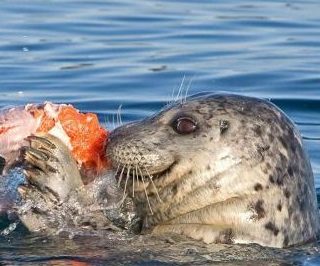
Study says seals eat more Chinook than Southern resident killer whales
Seals are eating more Chinook than Southern resident killer whales. That’s bad for both endangered species’ recoveries. “The seals might not be the enemy as much as the problem is that we’ve lost forage fish available to them,” said Joe Gaydos, science director of the SeaDoc Society on Orcas Island. According to a recent Canadian study, the amount of Chinook salmon eaten by seals in the Salish Sea has increased from 68 metric tons in 1970 to 625 metric tons in 2015. That’s double the amount Southern resident killer whales ate in 2015 in the same location, and six times more than commercial and recreational fisheries according to the study. Continue reading the story here 12:20
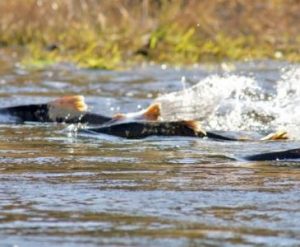
Feds Facing Order to Redirect Klamath River Water for Salmon
Two Native American tribes sued the U.S. Bureau of Reclamation last year, claiming its bungled management of Klamath River waterways allowed a deadly parasite to infect 91 percent of endangered juvenile Coho and Chinook salmon. The Yurok and Hoopa Valley Tribes say they depend on the salmon for subsistence, income and for traditional ceremonies that define their people. Lawyers for the federal government and an industry group of farmers and ranchers argue that diverting water to help salmon will harm businesses that support local jobs and communities and threaten another set of endangered fish, the shortnose sucker and Lost River sucker. In separate complaints against the federal government, the tribes say infection rates caused by the deadly parasite C. shasta, should have required the bureau to review its Klamath Irrigation Project’s impact on threatened salmon two years ago, but the bureau failed to take action in violation of the Endangered Species Act.During a hearing Friday, U.S. District Judge William Orrick III agreed the bureau should have reviewed the project when infection rates climbed to 81 percent in 2014 and 91 percent in 2015, well beyond the maximum 49 percent estimated in a 2013 biological opinion issued by co-defendant National Marine Fisheries Service. Read the story here 16:47
Trading Salmon for Almonds
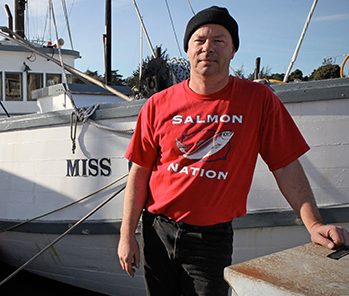 Northern California fishermen have endured an extremely difficult year. Fishery managers closed the entire commercial salmon fishing season for half of June and all of July in much of Northern California, and in general, ocean fishing has been poor the past few years off the California coast. The drought is to blame, along with excessive water diversions from the streams where Chinook salmon spawn. So it’s frustrating for commercial fishermen like Mike Hudson of Berkeley to hear that another part of the state’s food industry—almonds—is expecting a record crop in 2016. Almond farmers draw water from the same river systems in which Chinook salmon lay and fertilize their eggs, and to Hudson—a longtime critic of unsustainable agriculture, including growing thirsty crops like almonds in the dry San Joaquin Valley—it appears as though the farmer’s gain is his loss. Read the story here 18:31
Northern California fishermen have endured an extremely difficult year. Fishery managers closed the entire commercial salmon fishing season for half of June and all of July in much of Northern California, and in general, ocean fishing has been poor the past few years off the California coast. The drought is to blame, along with excessive water diversions from the streams where Chinook salmon spawn. So it’s frustrating for commercial fishermen like Mike Hudson of Berkeley to hear that another part of the state’s food industry—almonds—is expecting a record crop in 2016. Almond farmers draw water from the same river systems in which Chinook salmon lay and fertilize their eggs, and to Hudson—a longtime critic of unsustainable agriculture, including growing thirsty crops like almonds in the dry San Joaquin Valley—it appears as though the farmer’s gain is his loss. Read the story here 18:31
Start of the wave? Sudden boatloads of Chinook salmon off Alberni raise hopes
 Up and down the West Coast commercial fishermen are filling harbours waiting and hoping for an opening to fish Chinook salmon. Despite preliminary estimates of a huge return, the best in decades, the fish haven’t shown up as predicted so nets that are many people’s livelihoods haven’t even gone into the water this season. But some optimism is showing up now for those who’ve been struggling. Surrounded by boats in Port Alberni’s harbour all waiting for the commercial opening for the Chinook salmon fishery Stephanie Cook is doing what she can to stop worrying. “It’s very stressful, very stressful wondering if you’re going to catch any or if there’s any out there,” says Cook aboard her boat. The 30-year-old from Alert Bay has never faced a year like this before. One that’s testing even the most experienced on this coast. Video, read the story here 08:47
Up and down the West Coast commercial fishermen are filling harbours waiting and hoping for an opening to fish Chinook salmon. Despite preliminary estimates of a huge return, the best in decades, the fish haven’t shown up as predicted so nets that are many people’s livelihoods haven’t even gone into the water this season. But some optimism is showing up now for those who’ve been struggling. Surrounded by boats in Port Alberni’s harbour all waiting for the commercial opening for the Chinook salmon fishery Stephanie Cook is doing what she can to stop worrying. “It’s very stressful, very stressful wondering if you’re going to catch any or if there’s any out there,” says Cook aboard her boat. The 30-year-old from Alert Bay has never faced a year like this before. One that’s testing even the most experienced on this coast. Video, read the story here 08:47
What happened to all the Chinook Salmon? New research points to potential predators
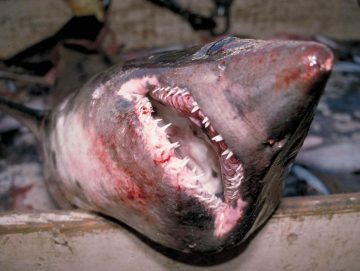 In the 1960s, king salmon were abundant in Alaska, and it stayed that way through the 90s. After the new millennium, though, Chinook numbers fell — and they’ve remained low since. “People have scratched their heads and said, ‘Where are all the kings? What happened to all the kings?’” said Andy Seitz, an associate professor at the University of Alaska Fairbanks School of Fisheries and Ocean Sciences. At a lecture in Unalaska this week, Seitz explained how his research team has studied adult Chinook in the Bering Sea for the last three years. The project relied on pop-up satellite tags, which attach to salmon and measure the water temperature, depth, and ambient light of their environment. Seitz and his team think warm-blooded salmon sharks ate the kings and their tags, and the odd data was recorded when fish were trapped in the sharks’ guts. He also said they found five instances where marine mammals and other unidentified predators could have killed Chinook. Read the story here 18:41
In the 1960s, king salmon were abundant in Alaska, and it stayed that way through the 90s. After the new millennium, though, Chinook numbers fell — and they’ve remained low since. “People have scratched their heads and said, ‘Where are all the kings? What happened to all the kings?’” said Andy Seitz, an associate professor at the University of Alaska Fairbanks School of Fisheries and Ocean Sciences. At a lecture in Unalaska this week, Seitz explained how his research team has studied adult Chinook in the Bering Sea for the last three years. The project relied on pop-up satellite tags, which attach to salmon and measure the water temperature, depth, and ambient light of their environment. Seitz and his team think warm-blooded salmon sharks ate the kings and their tags, and the odd data was recorded when fish were trapped in the sharks’ guts. He also said they found five instances where marine mammals and other unidentified predators could have killed Chinook. Read the story here 18:41
Yurok Tribe Files Intent to Sue National Marine Fisheries Service and the Bureau of Reclamation
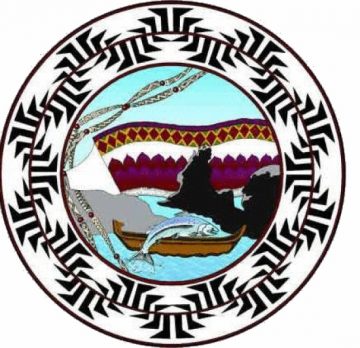 In response to massive fish disease outbreaks in back-to-back years on the Klamath River, the Yurok Tribe submitted a 60-day notice of intent to sue the National Marine Fisheries Service and the Bureau of Reclamation. “We cannot stand by and do nothing while our salmon hover over the brink of extinction,” said Thomas P. O’Rourke Sr., Chairman of the Yurok Tribe. “We will not continue to watch water managers jeopardize the fate of our fish and our river.” 91 percent of the juvenile, Klamath salmon were infected with a deadly parasite in 2015, as were a nearly identical number of fish in 2014. Given the nearly 100 percent mortality rate associated with the disease, approximately 90 percent of the Chinook salmon and likely an equal quantity of coho died in the main-stem Klamath River during those years, according to the notice. This year’s predicted adult salmon run is one of the lowest on record, which forced the Yurok Tribe to make a difficult decision to completely forgo all commercial fishing in 2016. Read the rest here 15:22
In response to massive fish disease outbreaks in back-to-back years on the Klamath River, the Yurok Tribe submitted a 60-day notice of intent to sue the National Marine Fisheries Service and the Bureau of Reclamation. “We cannot stand by and do nothing while our salmon hover over the brink of extinction,” said Thomas P. O’Rourke Sr., Chairman of the Yurok Tribe. “We will not continue to watch water managers jeopardize the fate of our fish and our river.” 91 percent of the juvenile, Klamath salmon were infected with a deadly parasite in 2015, as were a nearly identical number of fish in 2014. Given the nearly 100 percent mortality rate associated with the disease, approximately 90 percent of the Chinook salmon and likely an equal quantity of coho died in the main-stem Klamath River during those years, according to the notice. This year’s predicted adult salmon run is one of the lowest on record, which forced the Yurok Tribe to make a difficult decision to completely forgo all commercial fishing in 2016. Read the rest here 15:22
Chinook Salmon: 9 Facts About Oregon’s Official State Fish
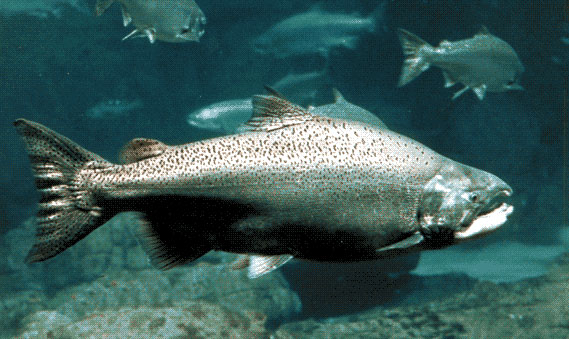 The state of Oregon designated the Chinook or king salmon as its state fish in 1961. The newly minted state of Alaska then followed suit in 1962. Here are nine facts about the Chinook salmon that help to explain why it is so important to fishing in Oregon and elsewhere. 1. The Chinook is the biggest of all of the Pacific salmons, growing as long as 53 inches and weighing as much as 126 pounds,,, Read the rest here 09:54
The state of Oregon designated the Chinook or king salmon as its state fish in 1961. The newly minted state of Alaska then followed suit in 1962. Here are nine facts about the Chinook salmon that help to explain why it is so important to fishing in Oregon and elsewhere. 1. The Chinook is the biggest of all of the Pacific salmons, growing as long as 53 inches and weighing as much as 126 pounds,,, Read the rest here 09:54
Editorial: Time to speak up for commercial fishing
 Last week included one of the signature events on the Pacific Northwest’s annual calendar: the setting of spring fishing seasons on the Columbia River. The forecast for the important spring Chinook run is about 300,000 to the river’s mouth, about 28 percent fewer than last year but more than the 10-year average of 285,000. Forecasts are one thing and reality quite another, but there is a good chance that fishermen and the businesses that rely on them will have a fun few weeks from March 1 to April 9. Read the rest here 15:17
Last week included one of the signature events on the Pacific Northwest’s annual calendar: the setting of spring fishing seasons on the Columbia River. The forecast for the important spring Chinook run is about 300,000 to the river’s mouth, about 28 percent fewer than last year but more than the 10-year average of 285,000. Forecasts are one thing and reality quite another, but there is a good chance that fishermen and the businesses that rely on them will have a fun few weeks from March 1 to April 9. Read the rest here 15:17
Wasting water to kill fish?
The Stanislaus River Salmon Festival  is Saturday. And so far a record 6,000 endangered Chinook salmon have passed through a high-tech weir near Riverbank. “There’s no cause for celebration,” noted biologist and Fishbo principal Andrea Fuller who has been studying the Stanislaus River and its fish for 20 years. That’s because Fuller said the federal government’s pulse flow releases from New Melones Reservoir during the fourth year of severe drought has created conditions that have water temperatures 5 degrees higher than normal. That is expected to translate into a much higher kill rate for eggs. Read the rest here 08:57
is Saturday. And so far a record 6,000 endangered Chinook salmon have passed through a high-tech weir near Riverbank. “There’s no cause for celebration,” noted biologist and Fishbo principal Andrea Fuller who has been studying the Stanislaus River and its fish for 20 years. That’s because Fuller said the federal government’s pulse flow releases from New Melones Reservoir during the fourth year of severe drought has created conditions that have water temperatures 5 degrees higher than normal. That is expected to translate into a much higher kill rate for eggs. Read the rest here 08:57
Do Not Blame the Fish – Alicia Rae
 The commercial fishing fleet is to “fault” for the failure of the sports fishermen, in the public mindset. They blame the commercial fleet of stealing “their” target specie, Chinook salmon. Although, they do not factor in their effect on the salmon’s population, with urbanization of the salmon’s native stream, destroying the prime environment for the maximum survival rate and harvesting of the optimal genetic material. Do not blame the fish for getting smaller and the likelihood of being able to catch one simile. The is to blame, not the commercial fleet and definitely not the fish. Read the rest here 08:06
The commercial fishing fleet is to “fault” for the failure of the sports fishermen, in the public mindset. They blame the commercial fleet of stealing “their” target specie, Chinook salmon. Although, they do not factor in their effect on the salmon’s population, with urbanization of the salmon’s native stream, destroying the prime environment for the maximum survival rate and harvesting of the optimal genetic material. Do not blame the fish for getting smaller and the likelihood of being able to catch one simile. The is to blame, not the commercial fleet and definitely not the fish. Read the rest here 08:06
Biologists hope chinook salmon’s rebound will continue
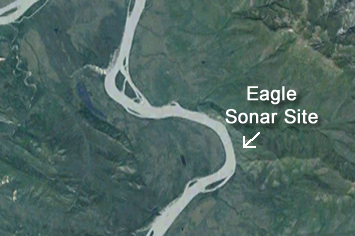 The number of chinook salmon entering the Yukon has met minimum targets for the second year in a row. This year, 57,000 fish have been counted in the Yukon River at Eagle, Alaska, just above the target of 55,000. Biologists the number is somewhat encouraging, but say the problem of declining chinook has not been solved. This year’s number still pales in comparison to average run sizes in the 1990s which measured 150,000 fish. Pauline Frost, chair of the Yukon Salmon Sub-Committee, says a ban on salmon harvesting in Alaska has made a difference. Read the rest here 17:59
The number of chinook salmon entering the Yukon has met minimum targets for the second year in a row. This year, 57,000 fish have been counted in the Yukon River at Eagle, Alaska, just above the target of 55,000. Biologists the number is somewhat encouraging, but say the problem of declining chinook has not been solved. This year’s number still pales in comparison to average run sizes in the 1990s which measured 150,000 fish. Pauline Frost, chair of the Yukon Salmon Sub-Committee, says a ban on salmon harvesting in Alaska has made a difference. Read the rest here 17:59
Washington and Oregon officials today cancelled gillnetting scheduled for tonight in the lower Columbia River.
 Biologist Jeff Whisler of the Oregon Department of Fish and Wildlife said the commercial fleet has caught 3,298 summer chinook salmon in two earlier nights of fishing. That number is 99 percent of the commercial allocation. Whisler said the commercials are projected to catch another 700 chinook if they fished tonight. The Columbia River Technical Advisory Committee has upgraded the forecast for the summer chinook run to 108,000, the largest since at least 1960. The sockeye run was upgraded Monday to 500,000, the third largest on record. link 14:34
Biologist Jeff Whisler of the Oregon Department of Fish and Wildlife said the commercial fleet has caught 3,298 summer chinook salmon in two earlier nights of fishing. That number is 99 percent of the commercial allocation. Whisler said the commercials are projected to catch another 700 chinook if they fished tonight. The Columbia River Technical Advisory Committee has upgraded the forecast for the summer chinook run to 108,000, the largest since at least 1960. The sockeye run was upgraded Monday to 500,000, the third largest on record. link 14:34
Warm water expected to keep killing Willamette River salmon
 Higher water temperatures in the Willamette River are most likely the cause of spring Chinook salmon deaths, according to fish biologists from the Oregon Department of Fish and Wildlife.According to ODFW, this year Chinook are dying earlier than usual. Most spring Chinook salmon usually die in the fall after they have spawned. The good news: More than 51,000 fish have crossed at Willamette Falls, well above the 50-year average of 41,000 fish. Read the rest here 14:46
Higher water temperatures in the Willamette River are most likely the cause of spring Chinook salmon deaths, according to fish biologists from the Oregon Department of Fish and Wildlife.According to ODFW, this year Chinook are dying earlier than usual. Most spring Chinook salmon usually die in the fall after they have spawned. The good news: More than 51,000 fish have crossed at Willamette Falls, well above the 50-year average of 41,000 fish. Read the rest here 14:46
Chinook closures impede summer chum subsistence
 Summer chum and Chinook salmon have begun their runs along the Yukon River. Wildlife managers and fishermen met via teleconference Tuesday to discuss river conditions and the salmon’s progress upstream. Community members reported summer chum as far upriver as Huslia and Ruby, with Chinook salmon fast on their heels. However, the much-coveted kings may not be a welcome sight to fishermen this year. “We have to eat along this river; everybody has to eat. They can’t live out of the store,” said Martha, a fisherman in Ruby. Read the rest here 10:31
Summer chum and Chinook salmon have begun their runs along the Yukon River. Wildlife managers and fishermen met via teleconference Tuesday to discuss river conditions and the salmon’s progress upstream. Community members reported summer chum as far upriver as Huslia and Ruby, with Chinook salmon fast on their heels. However, the much-coveted kings may not be a welcome sight to fishermen this year. “We have to eat along this river; everybody has to eat. They can’t live out of the store,” said Martha, a fisherman in Ruby. Read the rest here 10:31
Ocean Salmon Season Will Open April 4 by Dan Bacher
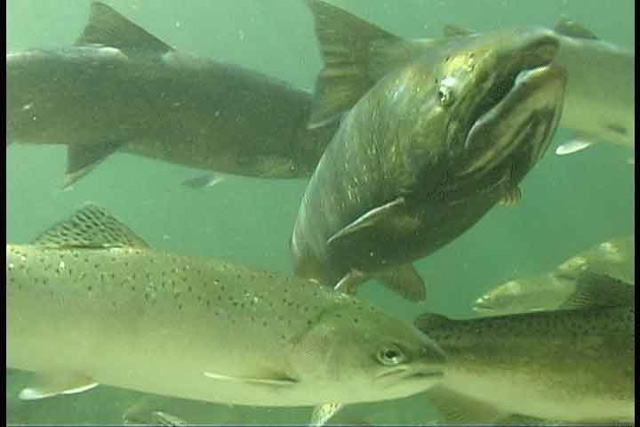 The recreational salmon fishing season is slated to begin in the Fort Bragg, San Francisco and Monterey South regions of the California coast on Saturday, April 4, 2015. In spite of the record drought, the outlook for this year’s season is promising, due to an abundance of both Sacramento and Klamath River Chinook salmon. On March 12, the Pacific Fishery Management Council (PFMC) adopted three public review options for the 2015 recreational and commercial salmon seasons off the West Coast. Read the rest here 10:01
The recreational salmon fishing season is slated to begin in the Fort Bragg, San Francisco and Monterey South regions of the California coast on Saturday, April 4, 2015. In spite of the record drought, the outlook for this year’s season is promising, due to an abundance of both Sacramento and Klamath River Chinook salmon. On March 12, the Pacific Fishery Management Council (PFMC) adopted three public review options for the 2015 recreational and commercial salmon seasons off the West Coast. Read the rest here 10:01
Despite drought, Bay Area salmon fishermen see hope for 2015 season
 Bay Area commercial salmon fisherman got a jolt of good news this week in the form of population data that could bode well for the upcoming season. The Pacific Fisheries Management Council released estimates for the number of chinook salmon that returned from the Pacific Ocean in the fall to spawn in rivers where they were born or released from hatcheries. The estimate for the Sacramento River, the top spawning ground in California, was relatively robust, considering the state’s three-year drought. Read the rest here 19:03
Bay Area commercial salmon fisherman got a jolt of good news this week in the form of population data that could bode well for the upcoming season. The Pacific Fisheries Management Council released estimates for the number of chinook salmon that returned from the Pacific Ocean in the fall to spawn in rivers where they were born or released from hatcheries. The estimate for the Sacramento River, the top spawning ground in California, was relatively robust, considering the state’s three-year drought. Read the rest here 19:03
Salmon can adapt to warmer environment, study says
![]() With climate change heating up British Columbia’s rivers, there are growing concerns about the vulnerability of cold-water species such as salmon. But a shows salmon may have the ability to adapt to a warming world because Chinook that lay larger eggs produce offspring that have greater heat tolerance. Read more here 10:39
With climate change heating up British Columbia’s rivers, there are growing concerns about the vulnerability of cold-water species such as salmon. But a shows salmon may have the ability to adapt to a warming world because Chinook that lay larger eggs produce offspring that have greater heat tolerance. Read more here 10:39
All Hail the King: Time to get some fresh chinook salmon from the Monterey Bay
 Commercial salmon fishing season opened May 1, and for those of us who don’t sport fish or have a good, generous friend who does, that means we can finally enjoy fresh salmon at home. With commercial crews working out of Santa Cruz, Moss Landing and Monterey harbors, shoppers can purchase salmon just hours after it’s been pulled from the ocean. Late last week, however, the retail price for whole salmon was around $14 per pound, while fillets were fetching about $24 a pound. Read more here 11:03
Commercial salmon fishing season opened May 1, and for those of us who don’t sport fish or have a good, generous friend who does, that means we can finally enjoy fresh salmon at home. With commercial crews working out of Santa Cruz, Moss Landing and Monterey harbors, shoppers can purchase salmon just hours after it’s been pulled from the ocean. Late last week, however, the retail price for whole salmon was around $14 per pound, while fillets were fetching about $24 a pound. Read more here 11:03






 In a slap in the face to fishermen, Tribes, environmental justice advocates, conservationists and family farmers, President Obama on December 16 signed the Water Infrastructure Improvements for the Nation (WIIN) Act into law with its environmentally destructive Big Ag rider sponsored by Senator Dianne Feinstein (D-CA) and Congressman Kevin McCarthy (R-CA). The controversial rider in the bill, opposed by retiring Senator Barbara Boxer, taints an otherwise good bill that sponsors water projects across the nation. The last minute rider, requested by corporate agribusiness interests, allows San Joaquin Valley growers and Southern California water agencies to pump more water out of the Delta, driving Sacramento River winter-run Chinook salmon, Central Valley steelhead, Delta and longfin smelt, green sturgeon and other fish species closer and closer to extinction, according to Delta advocates.
In a slap in the face to fishermen, Tribes, environmental justice advocates, conservationists and family farmers, President Obama on December 16 signed the Water Infrastructure Improvements for the Nation (WIIN) Act into law with its environmentally destructive Big Ag rider sponsored by Senator Dianne Feinstein (D-CA) and Congressman Kevin McCarthy (R-CA). The controversial rider in the bill, opposed by retiring Senator Barbara Boxer, taints an otherwise good bill that sponsors water projects across the nation. The last minute rider, requested by corporate agribusiness interests, allows San Joaquin Valley growers and Southern California water agencies to pump more water out of the Delta, driving Sacramento River winter-run Chinook salmon, Central Valley steelhead, Delta and longfin smelt, green sturgeon and other fish species closer and closer to extinction, according to Delta advocates. 



























